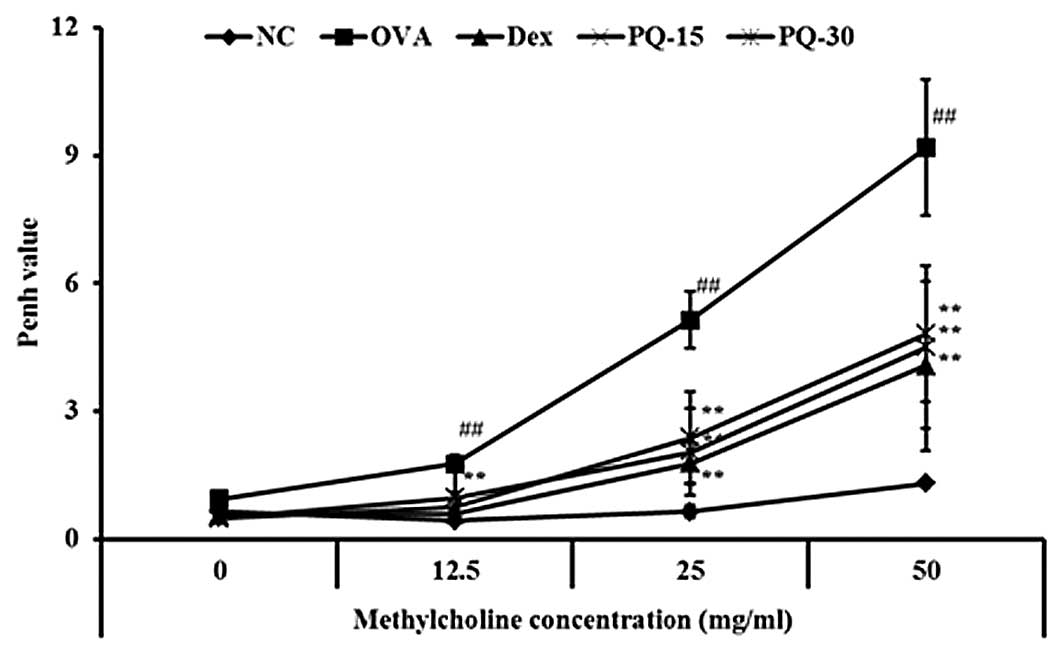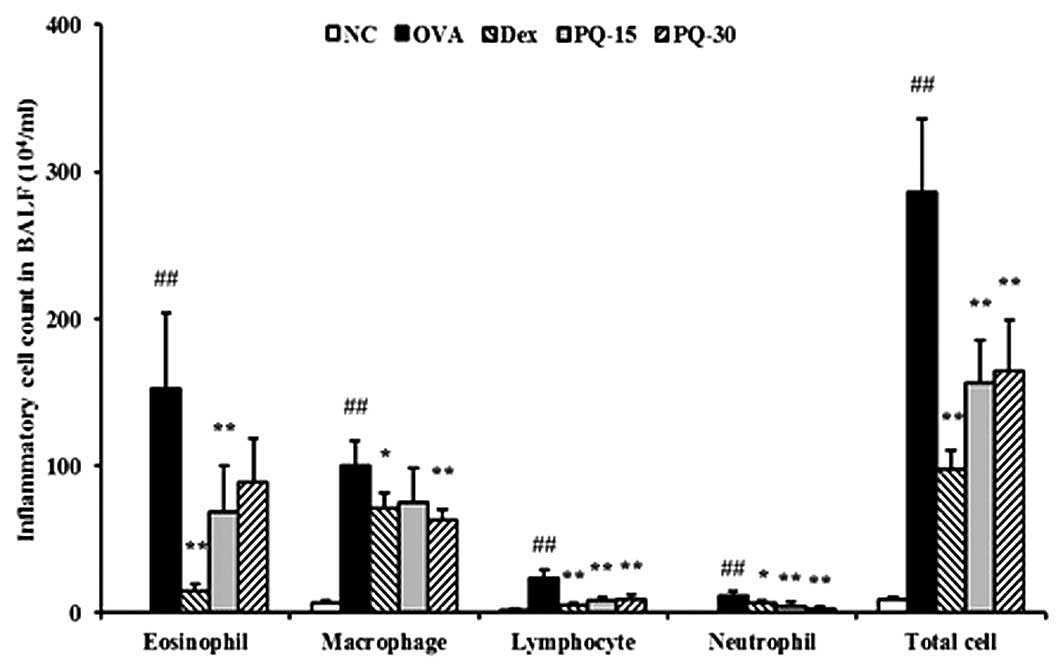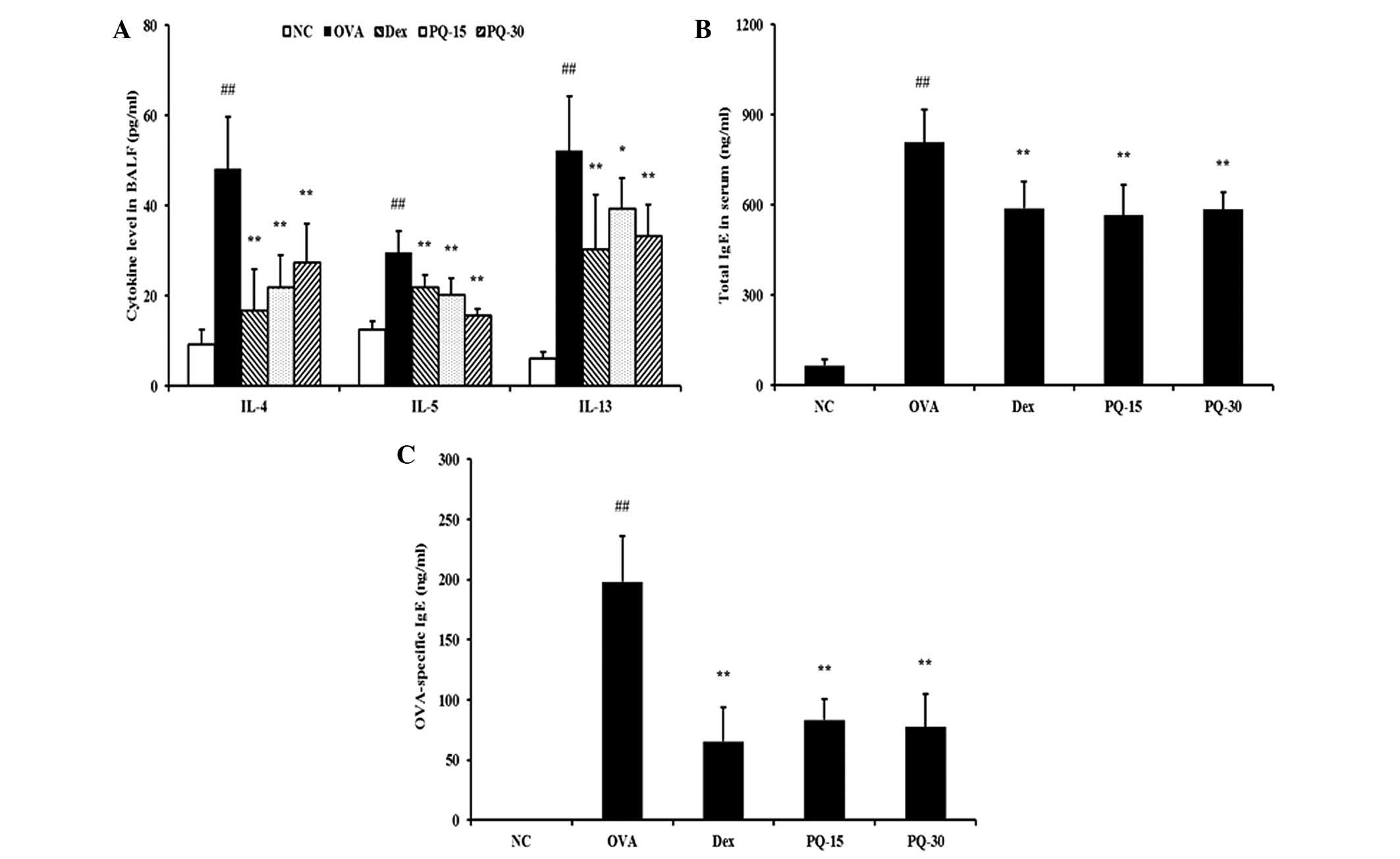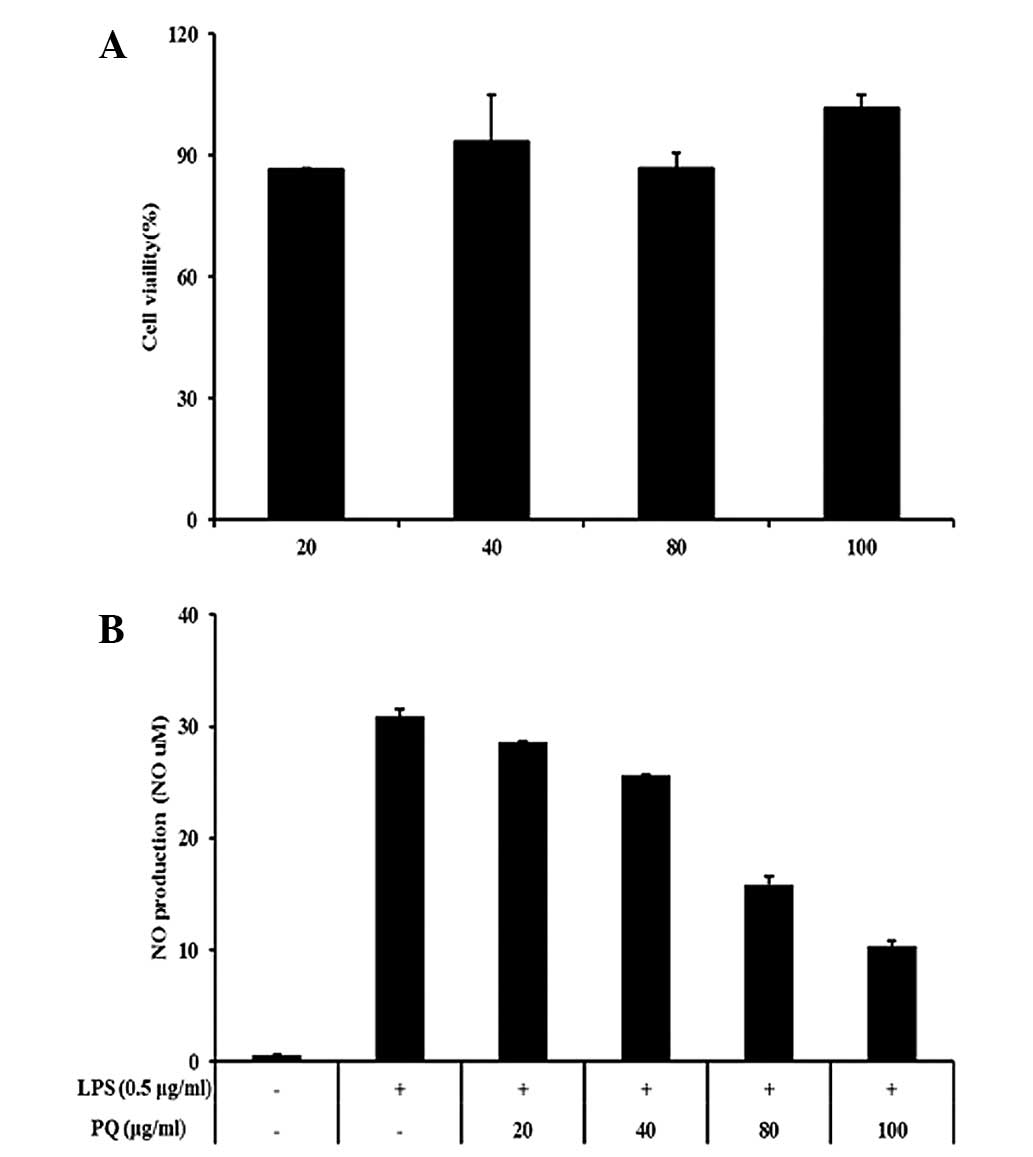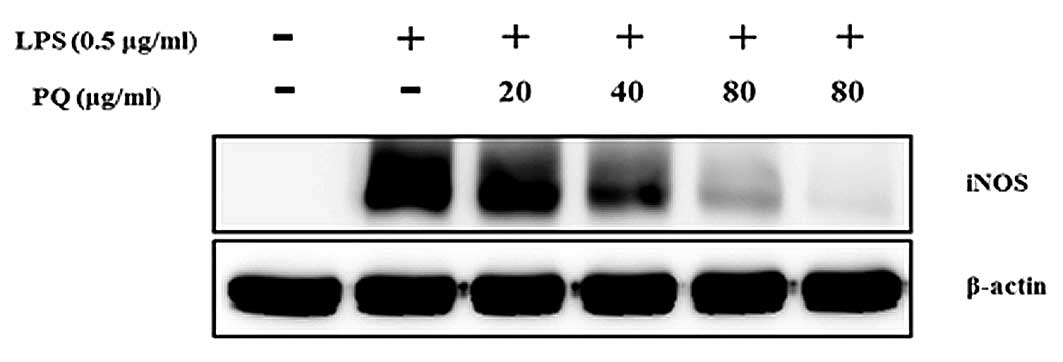Inhibitory effects of Picrasma quassioides (D.Don) Benn. on airway inflammation in a murine model of allergic asthma
- Authors:
- Published online on: June 13, 2014 https://doi.org/10.3892/mmr.2014.2322
- Pages: 1495-1500
Abstract
Introduction
Inflammation is a complex process involving various mediators. In particular, nitric oxide (NO) is considered as an important inflammatory mediator. NO derived from inducible NO synthase (iNOS) is crucial in airway inflammation (1). Allergic asthma features airway inflammation, airway hyperresponsiveness (AHR) and mucus hypersecretion. The development of allergic asthma results in iNOS overexpression in the airway, which induces asthmatic responses. A previous study demonstrated that iNOS expression indirectly induced the activation of T helper (Th)2 lymphocytes to contribute to the pathophysiological alterations of asthma. The Th2 lymphocytes produced various Th2 cytokines, including interleukin (IL)-4, IL-5 and IL-13. Th2 cytokines were closely associated with the development of allergic asthma via the secretion of allergen-specific immunoglobulin (Ig)E, chemokines, proinflammatory mediators and chemoattractants (2).
Picrasma quassioides (D.Don) Benn. (PQ) is a medicinal herb belonging to the family Simaroubaceae. In China, PQ is used as a traditional herbal medicine for the treatment of numerous diseases, including diarrhea, dysentery, inflammation, microbial infection and fever. Previous studies have shown that PQ has anti-inflammatory, anticancer and anti-oxidant effects in in vitro and in vivo experiments (3,4). Liu et al (5) demonstrated that PQ attenuated inflammatory bowel disease. Additionally, Fan et al (6) showed that PQ inhibited the production of inflammatory mediators in lipopolysaccharide (LPS)-stimulated macrophage cells and an adjuvant-induced model of arthritis. However, to the best of our knowledge, no study has investigated the protective effects of PQ on airway inflammation in an ovalbumin (OVA)-sensitized/challenged allergic asthma model.
Therefore, the present study investigated the effect of PQ on airway inflammation using an OVA-sensitized/challenged allergic asthma murine model by measuring inflammatory cell counts, Th2 cytokine and IgE levels, and by performing an histological analysis of the lung tissue of the mice. To investigate the anti-inflammatory mechanism of PQ, the levels of NO, proinflammatory cytokines and iNOS expression were evaluated in the RAW264.7 murine macrophage cell line.
Materials and methods
Cell culture and cell viability
The RAW264.7 (American Type Culture Collection, Manassas, VA, USA) murine macrophage cell line was maintained in Dulbecco’s modified Eagle’s medium (DMEM) supplemented with 10% heat-inactivated fetal bovine serum and antibiotic-antimycotic (Gibco-BRL, Carlsbad, CA, USA), including penicillin, streptomycin and Fungizone at 37°C in a 5% CO2 and 95% air incubator. The cell viability following PQ exposure was measured using a 3-(4,5-dimethylthiazol-2-yl)-2,5-diphenyltetrazolium bromide (MTT; Amresco, Solon, OH, USA) assay. The RAW264.7 cells were cultured in 96-well plates at a density of 1×104 cells/well. The PQ extract was obtained from the Plant Extract Bank at Korea Research Institute of Bioscience and Biotechnology (KRIBB; PB3612.2; Ochang-eup, Korea). The PQ extract was added to each individual well at a concentration of 20, 40, 80 or 100 μg/ml, and then the plates were incubated for 24 h. MTT solution (10 μl) was added to each well, and the plates were incubated for 4 h at 37°C. Following incubation, 100 μl dimethylsulfoxide was added to each well for the solubilization of formazan. The optical density was measured at 570 nm using a microplate reader (Molecular Devices Co., Sunnyvale, CA, USA).
Determination of NO production
Cells (5×105 cells/ml) were seeded in 96-well plates with phenol red-free DMEM, treated with different concentrations of PQ (20, 40, 80 and 100 μg/ml) 1 h prior to LPS treatment and then incubated in the presence of LPS (0.5 μg/ml) for 24 h. The nitrite accumulation in the culture medium was measured using the Griess Reagent system (Promega Corporation, Madison, WI, USA). The absorbance at 540 nm was measured using a microplate reader (Molecular Devices, LLC).
Immunoblot analysis
The cells were treated as described in the previous sections and then incubated in the presence of LPS (0.5 μg/ml) for 1 or 24 h. The cells were collected by centrifugation, washed twice with phosphate-buffered saline (PBS), and suspended using CelLytic MT Mammalian Tissue Lysis/Extraction Reagent (Sigma-Aldrich, St. Louis, MO, USA) containing protease inhibitors. The protein concentration was determined using a protein assay reagent (Bio-Rad Laboratories, Inc., Hercules, CA, USA), according to the manufacturer’s instructions. Equal quantities of total cellular protein (30 g) were resolved by 10% sodium dodecyl sulfate-polyacrylamide gel electrophoresis and transferred to nitrocellulose membranes. The membranes were incubated with blocking solution (5% skimmed milk), followed by an overnight incubation at 4°C with the appropriate primary antibody. The following primary antibodies and dilutions were used: Polyclonal anti-β-actin (anti-rabbit, 1:2,000 dilution; Cell Signaling Inc., Danvers, MA, USA) and polyclonal anti-iNOS (anti-rabbit, 1:200 dilution; Enzo Life Sciences Inc., Farmingdale, MA, USA). The blots were washed three times with Tris-buffered saline containing Tween-20 (TBST) and then incubated with a 1:10,000 dilution of horseradish peroxidase-conjugated secondary antibody (Jackson ImmunoResearch Laboratories, Inc., West Grove, PA, USA) for 30 min at room temperature. The blots were washed three times with TBST, and then developed using an enhanced chemiluminescence kit (Thermo Fisher Scientific Inc., San Jose, CA, USA).
Experimental procedure
Specific pathogen-free female BALB/c mice (weight, 19–21 g; age, 6–8 weeks) were purchased from Koatech Co. (Pyeongtaek, Korea). The mice were divided into five groups (n=7 per group) and housed under standard conditions (temperature, 22±2°C; humidity, 55±5%; 12-h light/dark cycle) with food and water ad libitum. All experimental procedures were approved by the Institutional Animal Care and Use Committee of KRIBB. The mice were divided into five groups (n=7), and allergic asthma was induced by OVA in four groups. Each mouse was immunized by intraperitoneal injection of 20 μg OVA emulsified with 2 mg aluminum hydroxide in 200 μl PBS buffer (pH 7.4) on days 0 and 14. On days 21–23, the mice were forced to inhale a 1% (w/v) OVA solution aerosolized using an ultrasonic nebulizer (NE-U12; Omron Corp., Tokyo, Japan) for 1 h. PQ was administered by oral gavage at dose levels of 15 and 30 mg/kg 1 h prior to the OVA challenge. Dexamethasone was used as the positive control drug, and was administered by oral gavage at a dose of 3 mg/kg.
Measurement of AHR
Twenty-four hours after the final OVA challenge, the AHR was measured by the indirect usage of single-chamber, whole-body plethysmography (Allmedicus Co., Ltd., Seoul, Korea). Each mouse was placed in a plastic chamber and exposed to methacholine aerosols at increasing concentrations (12.5–50 mg/ml in PBS) for 3 min. Following each methacholine challenge, the Penh values were measured for 3 min.
Measurement of inflammatory cell counts in bronchoalveolar lavage (BAL) fluid
To obtain BAL fluid, mice were sacrificed 48 h after the final OVA challenge with an intraperitoneal injection of phenobarbital (50 mg/kg; Hanlim Pharm., Co., Seoul, Republic of Korea) and tracheotomy was performed. The trachea was cannulated and the left bronchi were tied for histopathological examination. Following instilling ice-cold PBS (0.4 ml) into the lung, BALF was obtained by three successive aspirations (total volume 1.2 ml) via tracheal cannulation. The total numbers of inflammatory cells were determined by counting cells in at least five squares of a hemocytometer (Reichert, Buffalo, NY, USA) following the exclusion of dead cells by Trypan blue staining. The differential cell count of the BAL fluid was performed using Diff-Quik® staining reagent (B4132-1A; IMEB Inc., San Marcos, CA, USA), according to the manufacturer’s instructions. Blood was collected from the inferior vena cava and centrifuged (200 g, 10 min, 4°C). The supernatant was stored at −70°C.
Measurement of the levels of cytokines in BAL fluid and IgE in serum
The levels of certain cytokines (IL-4, IL-5 and IL-13) in the BAL fluid were measured using ELISA kits (R&D Systems, Minneapolis, MN, USA), according to the manufacturer’s instructions. The levels of total IgE and OVA-specific IgE in the serum were measured by ELISAs. Microtiter plates were coated with anti-IgE antibodies (anti-mouse IgE; 10 g/ml; AbD Serotec, Oxford, UK) or OVA (Sigma-Aldrich) in PBS-Tween-20, and incubated with the serum samples. The plates were then washed four times, and 200 μl o-phenylenediamine dihydrochloride (Sigma-Aldrich) was added to each well. The plates were incubated for 10 min in the dark and the absorbance was measured at 450 nm using a microplate reader (Molecular Devices Co.).
Histopathological analysis of the lung tissue
The left lung tissue was fixed in 4% (v/v) paraformaldehyde, embedded in paraffin, sectioned at a thickness of 4 μm, and stained with hematoxylin and eosin solution (Sigma-Aldrich) or periodic acid-Schiff (PAS) (IMEB Inc.) to estimate the levels of inflammation and mucus production, respectively.
Statistical analysis
Data are expressed as the mean ± standard deviation. The statistical significance was determined using analysis of variance followed by a multiple comparison test with Dunnet’s adjustment. P<0.05 was considered to indicate a statistically significant difference.
Results
PQ reduces the AHR induced by OVA challenge
The OVA-sensitized/challenged mice exhibited a significant increase in AHR with the exposure to increasing concentrations of methacholine compared with that of the normal controls. The dexamethasone-treated mice showed a significant reduction in the AHR compared with that of the OVA-sensitized/challenged mice. The PQ-treated mice also exhibited a reduced AHR at the 25 and 50 mg/ml methacholine concentrations compared with that of the OVA-sensitized/challenged mice. These reductions were similar to the results of the dexamethasone-treated mice (Fig. 1).
PQ reduces the number of inflammatory cells in BAL fluid
The OVA-sensitized/challenged mice exhibited a significant increase in the number of inflammatory cells, in particular eosinophils, in the BAL fluid compared with that of the normal controls. However, the PQ-treated mice showed a markedly reduced number of inflammatory cells, including eosinophils, macrophages, lymphocytes and neutrophils, in the BAL fluid compared with that of the OVA-sensitized/challenged mice (Fig. 2).
PQ reduces the levels of proinflammatory cytokines in BAL fluid and IgE in serum
The levels of IL-4, IL-5 and IL-13 in the BAL fluid were significantly increased in the OVA-sensitized/challenged mice compared with those in the normal controls. By contrast, the administration of PQ treatment induced a significant reduction in these levels in the BAL fluid compared with those of the OVA sensitized/challenged mice (Fig. 3A). In addition, the levels of total IgE and OVA-specific IgE in the serum of the OVA-sensitized/challenged mice were significantly elevated compared with those in the normal controls. However, the PQ-treated mice exhibited a significant reduction in the levels of total IgE and OVA-specific IgE in the serum compared with those in the OVA-sensitized/challenged mice (Fig. 3B and C).
PQ decreases the levels of inflammatory cell infiltration and mucus production
Lung tissue from the OVA-sensitized/challenged mice exhibited infiltration of inflammatory cells into peribronchial and perivascular lesions, and mucus hypersecretion from the airway epithelial cells (Fig. 4). By contrast, the lung tissue from the PQ-treated mice showed markedly lower levels of inflammatory cell infiltration and mucus secretion compared with that from the OVA-sensitized/challenged mice.
PQ inhibits the production of NO in LPS-stimulated RAW264.7 cells
In this study, nontoxic concentrations of PQ (20, 40, 80 and 100 μg/ml; Fig. 5A) were tested for their ability to inhibit LPS-stimulated NO production. The LPS-stimulated cells exhibited an increase in the cellular NO levels compared with those in the non-stimulated cells. However, the cells pretreated with PQ showed inhibition of the production of NO in a concentration-dependent manner compared with that in the LPS-stimulated cells (Fig. 5B).
PQ suppresses iNOS expression in LPS-stimulated RAW264.7 cells
As shown in Fig. 6, the levels of iNOS protein expression were almost undetectable in the non-stimulated cells. The LPS-stimulated cells exhibited increased iNOS protein expression levels compared with those of the non-stimulated cells. However, the cells pre-treated with PQ showed an inhibition of the iNOS expression in a concentration-dependent manner.
Discussion
The present study evaluated the effects of PQ on inflammatory responses using an OVA-sensitized/challenged allergic asthma murine model and LPS-stimulated RAW264.7 cells. Administration of PQ resulted in a significant reduction in the elevated inflammatory cell counts, AHR, and levels of Th2 cytokines and IgE induced by the OVA challenge. PQ attenuated the infiltration of inflammatory cells into the airway and mucus hypersecretion. In addition, the LPS-stimulated RAW264.7 cells exhibited significantly reduced levels of NO production when treated with PQ. Furthermore, PQ inhibited the overexpression of iNOS caused by LPS treatment.
Airway inflammation is an important feature of allergic asthma. In the initiation or development of airway inflammation, Th2 cytokines are central in causing the release of various inflammatory mediators, including IL-4, IL-5 and IL-13 (7–10). These cytokines are involved in the maturation and activation of eosinophils, B-cell isotype switching and the release of chemokines and chemoattractants, which result in the phenotypes of allergic asthma, including airway inflammation, AHR and airway remodeling (11–14). In the present study, PQ reduced the number of inflammatory cells, AHR and the levels of IgE as a result of the reduction in the levels of IL-4, IL-5 and IL-13. These finding indicate that PQ effectively suppressed airway inflammation via the downregulation of Th2 cytokines. These results were consistent with the histological analysis of the lung tissue in the present study. The lung tissue from the PQ-treated mice exhibited a reduction in the recruitment of inflammatory cells into the airway and mucus production in the airway compared with those in the OVA-sensitized/challenged mice.
NO, an important inflammatory mediator, is a gaseous molecule synthesized by NOS that has numerous detrimental functions. NOS has three isoforms, constitutive NOS, endothelial NOS and iNOS. Of the NOS isoforms, iNOS is closely associated with the production of NO (15). A previous study has demonstrated that overproduction of NO acts as a crucial mediator of airway inflammation in allergic asthma (16). NO contributes to the infiltration of inflammatory cells, including neutrophils, macrophages and eosinophils (8). In addition, NO is a potent stimulator of the Th2 responses of allergic asthma. According to a previous study, increased NO production induced by iNOS aggravated the allergic asthmatic responses, including airway inflammation and AHR, via the elevation of the levels of Th2 cytokine release. In a previous study, iNOS knockout mice exhibited a reduction in NO production, resulting in a decrease in the Th2 cytokine levels in an allergic asthma model (1). Therefore, numerous anti-inflammatory materials have been developed that focus on the suppression of iNOS expression. A number of natural products have been investigated for their anti-inflammatory effects using numerous experimental models (3–6). In the present study, PQ inhibited the elevated production of NO in LPS-stimulated RAW264.7 cells in a concentration-dependent manner. PQ also suppressed the overexpression of iNOS induced by LPS treatment. These results indicate that PQ effectively inhibits inflammatory responses via the suppression of iNOS expression.
Numerous oriental medicine practitioners have administered herbal treatments to patients to cure various diseases and PQ has been used as a traditional herbal remedy for several disorders, particularly inflammatory diseases (5). The present study provided evidence of the anti-inflammatory effects of PQ using an OVA-sensitized/challenged allergic asthma murine model and LPS-stimulated RAW264.7 cells. These effects were consistent with the results of a previous study (6). Fan et al (6) demonstrated that PQ possesses protective effects against carrageenan-induced paw edema, xylene-induced ear edema and adjuvant-induced arthritis.
In conclusion, PQ effectively suppressed airway inflammation induced by OVA challenge in the present study. The anti-inflammatory effects of PQ were considered to be associated with the suppression of iNOS expression based on the results of the in vitro experiments. Therefore, this study suggests that PQ may be a potent therapeutic agent for airway inflammatory diseases, including allergic asthma.
Acknowledgements
This study was supported by a grant from the Korea Research Institute of Bioscience and Biotechnology Research Initiative program (grant no. KGM1221312) of the Republic of Korea.
References
|
Prado CM, Martins MA and Tibério IF: Nitric oxide in asthma physiopathology. ISRN Allergy. 2011:8325602011. View Article : Google Scholar : PubMed/NCBI | |
|
Schuijs MJ, Willart MA, Hammad H and Lambrecht BN: Cytokine targets in airway inflammation. Curr Opin Pharmacol. 13:351–361. 2013. View Article : Google Scholar : PubMed/NCBI | |
|
Jiao WH, Gao H, Zhao F, Lin HW, Pan YM, Zhou GX and Yao XS: Anti-inflammatory alkaloids form the stems of Picrasma qussioides BENNET. Chem Pharm Bull (Tokyo). 59:359–364. 2011. View Article : Google Scholar | |
|
Yin Y, Lee SK and Wang MH: Isolation and biological activities of an alkaloid compound (3-methylcanthin-5,6-dione) from Picrasma quassiodes (D.Don) Benn. Nat Prod Sci. 17:5–9. 2011. | |
|
Liu JF, Shao M, Zhai DW, Liu K and Wu LJ: Protective effect of 4-methoxy-5-hyfuoxycanthin-6-one, a natural alkaloid, on dextran sulfate sodium-induced rat colitis. Planta Med. 75:142–145. 2009. View Article : Google Scholar : PubMed/NCBI | |
|
Fan H, Qi D, Yang M, Fang H, Liu K and Zhao F: In vitro and in vivo anti-inflammatory effects of 4-methoxy-5-hydroxycanthin-6-one, natural alkaloid from Picrasma quassioides. Phytomedicine. 20:319–323. 2013. View Article : Google Scholar : PubMed/NCBI | |
|
Ra J, Lee S, Kim HJ, Jang YP, Ahn H and Kim J: Bambusae Caulis in Taeniam extract reduces ovalbumin-induced airway inflammation and T helper 2 responses in mice. J Ethnopharmacol. 128:241–247. 2010. View Article : Google Scholar : PubMed/NCBI | |
|
Nader MA, El-Awady MS, Shalaby AA and El-Aqamy DS: Sitagliptin exerts anti-inflammatory and anti-allergic effects in ovalbumin-induced murine model of allergic airway disease. Naunyn Schmidebergs Arch Pharmacol. 385:909–919. 2012. View Article : Google Scholar : PubMed/NCBI | |
|
Lee MY, Shin IS, Jeon WY, Lim HS, Kim JH and Ha H: Pinellia ternate Breitenbach attenuates ovalbumin-induced allergic airway inflammation and mucus secretion in a murine model of asthma. Immunopharmacol Immunotoxicol. 35:410–418. 2013. View Article : Google Scholar | |
|
Schmudde I, Laumonnier Y and Köhl J: Anaphylatoxins coordinate innate and adaptive immune responses in allergic asthma. Semin Immunol. 25:2–11. 2013. View Article : Google Scholar : PubMed/NCBI | |
|
Shin IS, Lee MY, Lim HS, Ha H, Seo CS, Kim JC and Shin HK: An extract of Crataegus pinnatifida fruit attenuates airway inflammation by modulation of matrix metalloproteinase-9 in ovalbumin induced asthma. PLoS One. 7:e457342012.PubMed/NCBI | |
|
Lee YT, Lee SS, Sun HL, Lu KH, Ku MS, Sheu JN, Ko JL and Lue KH: Effect of the fungal immunomodulatory protein FIP-fve on airway inflammation and cytokine production in mouse asthma model. Cytokine. 61:237–244. 2013. View Article : Google Scholar : PubMed/NCBI | |
|
Simoes DC, Xanthou G, Petrochilou K, Panoutsakopoulou V, Roussos C and Gratziou C: Osteopontin deficiency protects against airway remodeling and hyperresponsiveness in chronic asthma. Am J Respir Crit Care Med. 179:894–902. 2009. View Article : Google Scholar : PubMed/NCBI | |
|
Shen JJ, Chiang MS, Kuo ML, Leu YL, Hwang TL, Liou CJ and Huang WC: Partially purified extract and viscolin from Viscum coloratum attenuate airway inflammation and eosinophil infiltration in ovalbumin-sensitized mice. J Ethnopharmacol. 135:646–653. 2011.PubMed/NCBI | |
|
Koarai A, Ichinose M, Sugiura H, Tomaki M, Watanabe M, Yamagata S, Komaki Y, Shirato K and Hattori T: iNOS depletion completely diminishes reactive nitrogen-species formation after an allergic response. Eur Respir J. 20:609–616. 2002. View Article : Google Scholar | |
|
Deshane J, Zmijewski JW, Luther R, Gaggar A, Deshane R, Lai JF, Xu X, Spell M, Estell K, Weaver CT, Abraham E, Schwiebert LM and Chaplin DD: Free radical-producing myeloid-derived regulatory cells: potent activators and suppressors of lung inflammation and airway hyperresponsiveness. Mucosal Immunol. 4:503–518. 2011. View Article : Google Scholar |



